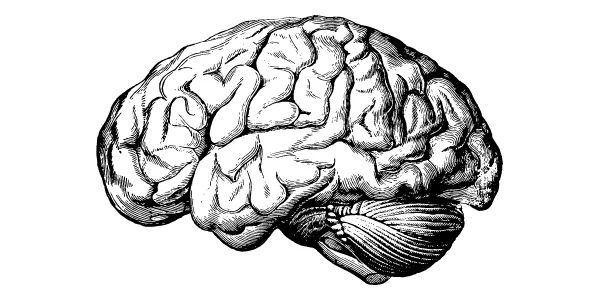
The Brain, DHA, Athletic Performance and Recovery
The Brain, DHA, Athletic Performance and Recovery
DHA is receiving a lot of focus in the world of sports nutrition because of its relation to the brain and necessity in athletic performance and recovery.
Studies show this essential fatty acid helps promote a healthy inflammatory response, support muscle mass, increasing endurance, improve reaction time and various other physiological effects that are crucial for athletes. [1]DHA is known as docosahexaenoic acid and is pronounced do-co-sa-hexa-e-no-ic acid.
It is an omega-3 polyunsaturated fatty acid and is a critical building block for the developing nervous system, eyes, mitochondria and sperm. DHA exists in every cell and every neuron in the whole body, making it one of the most important nutrients for the proper functioning and development of a human being.
This long chain polyunsaturated omega-3 fatty acid is a major lipid and is deemed for its necessity in daily cognitive behavior and function, vision, development and more.
DHA accumulates in greatest concentrations in the eyes and brain. In fact, DHA makes up over 90% of the omega-3 fatty acids in the brain along with 93% of the fatty acids in the retina of the eye. [2]
With a brain that is 60% fat, it is easy to see how critical it is to maintain sufficient levels of DHA for not only daily functions, but also for peak performance.
DHA, Neurotransmission and Neurogenesis in Athletic Performance
DHA's has effects on neurotransmission efficiency and supports the regulation of motor neuron responses. [3] This is part in how reaction times, hand-eye coordination and overall nervous system function is supported.
More specifically, the unique shape at the methyl end (the tail) of this 22 carbon atom fatty acid helps gives it interesting properties as it relates to electrophysiology and the functioning of the nervous system.
In their book Neurons and the DHA Principle, Raymond Valentine, Ph.D. and David Valentine, Ph.D. state,“Because DHA tails are in perpetual motion, these chains do not stand still long enough to bind with their neighbors to form hardened oils typical of butter or lard. Thus, the contortions of DHA chains keep the membrane surface in constant motion even in the extreme cold. DHA is responsible for this extreme motion because it keeps itself, neighboring chains, and other membrane components in a perpetual state of movement (e.g., spinning and lateral movement)… Neurons and sensory cells harness the motion in DHA tails to boost the speed of their signals. Hence, DHA becomes a pacemaker of brain speed and without it our sensory system would likely be much slower.” [4]
Additionally, nervous system development and maintenance is supported via different neurogenic properties of DHA.
1. DHA has been shown to up-regulate the expression of BDNF as well as another growth factor that is similar to BDNF, called Nerve Growth Factor (NGF). [5,6]
2. DHA also has been shown to help support the production of something called Synaptamide. Synaptamide (N-docosahexenoyethanolamine) is synthesized from DHA in the brain and it helps to promote neurite growth, synaptogenesis and neurogenesis in developing neurons. [7] In other words, for Synaptamide to be produced at healthy levels, DHA needs to be present.
3. DHA has been shown to also support the healthy expression of several different genes in the brain and entire central nervous system. [8]
4. DHA also is known to help with the healthy expression of different genes that relate to the hypothalamus and the suprachiasmatic nucleus (SCN), which helps regulate hormones in conjunction with the cycles of light and darkness. In short, the SCN helps to set and balance our circadian rhythm. [9]
5. DHA has also been shown to support both memory and reaction time. [10]
6. DHA has been shown to raise a child’s IQ when given to pregnant and lactating mothers at 1 g per day of DHA. [11]
7. DHA has been shown to support the integrity of the myelin sheath, which is the fatty substance that lines and acts as insulation to neurons. Similar to how insulation on electrical wires prevents energy loss, myelin helps to protect energy loss when electrical signals travel throughout the brain at faster than light speed and precision. [12]
Given the multitude of ways DHA is known to support the brain and nervous system, it isn't a surprise to see that DHA relates to performance enhancement and recovery in different ways too.
DHA and Athletic Performance and Recovery
It is understood that athletes need a large amount of calories for energy but it is often forgotten that an adequate amount of DHA is also needed for optimal brain and nervous system function.
Naturally, the human body does not produce enough DHA for this optimal performance and function so DHA must be consumed through the diet. The predominant source of DHA is fish and other seafood, but there is an easier and more direct source of it that will be discussed a bit further down.
A good place to begin for everyday humans as well as athletes is 500 mg of DHA per day with further improvements seen at levels of 1,000-2,000 mg of DHA per day. [13]
Over a period of 3-6 months, this as been shown to increase the omega 3 index percentage, which is an internationally respected blood test that shows the amount of DHA and EPA in the red blood cell membranes. [14]
Ideal percentages for humans and in particular, athletes, is around 8-12%. The average American percentage is between 3.5-4%. [15,16]
Not surprisingly, a recent study showed that 95% of NCAA Division 1 college athletes are not meeting the recommended dose of 500 mg DHA per day. [17]
The study looked at athletes in 34 different sports and showed that none (0%) of the athletes who completed the omega-3 Index, including those who consumed fish two or more times weekly, met the ideal of 8-12%.
In fact, the average Division 1 athlete has an omega-3 index of 4.0-4.5%.
This percentage poses a large problem for not only the general population but especially for high performance athletes. The International Olympic Conference (IOC) states that an athlete could need up to 2000 mg of DHA per day, which is not being met by most athletes. [18]
This 2000 mg suggestion per day for humans is what's established in The DHA Regimen, and will be discussed further below as well.
So what do the studies show if these levels were to be met or at the very least increased?
One particular study showed that adequate supplementation of DHA led to healthy inflammatory responses. Oxidative stress is common among athletes and can lead to muscle fatigue and an unhealthy state of chronic inflammation. DHA attenuates this natural inflammatory response in the body by increasing SPM (specialized pro-resolving mediators), which have been shown to have powerful abilities in supporting a healthy inflammatory response in the body. [19]
Another study showed that supplementation of omega-3’s to athletes led to decreased muscle soreness post training. The subjects were given 3 g DHA for four weeks and by the end of the trial, the supplemented group had significantly less muscle soreness than the group given the placebo. [20]
DHA supplementation has also been linked to muscle growth by decreasing muscle breakdown and increasing muscle protein synthesis (MPS). Results showed that supplementing 4g of DHA per day for 8 weeks led to a better MPS response to both insulin and amino acids, which are essential for not only building, but maintaining muscle mass. [21]
An additional intriguing benefit for athletes is the improvement in reaction time linked with supplementing DHA. Another study reported findings that supplementing DHA at 1.16 grams per day for six months led to improved reaction times in episodic and working memory. Through using computerized cognitive testing, the men in the study showed an increase in reaction time of 20%. [22]
This isn't a surprise either given that in all of the 120 million rod cells and 6 million cones in the retina of the eye, there exists in each of them DHA-enriched membrane disks that serve as light sensors.
DHA at 3.5 g per day for four weeks in elite female soccer players showed significant improvement in neuromotor function as well. [23]
DHA supports all of our essential functions such as vision, thinking, memory, learning, concentration and is absolutely essential for the modern athlete.
DHA rewires athletes' brains to react quicker, process more efficiently, increase visual processing, as well as serve as a neuroprotectant for all-around health. [24]
Amounts of DHA Needed and SourcesThe regimen of using 1,000-2,000 mg of DHA and EPA per day is established and what I discuss in The DHA Regimen here.
This regimen is of particular interest to coaches, athletes, clinicians, practitioners and anyone interested in achieving peak omega-3 index % levels and ensuring enough DHA is consumed throughout the week.
As stated earlier, typical sources of DHA consumption come through seafood like salmon and oysters, with an average serving of salmon (3 oz) provide about 1240 mg of DHA. [25]
This means that over a course of a week, a person would need to consume about 5.6-11.2 servings of salmon per week for a person to reach the 1,000-2,000 mg of DHA per day (7,000-14,000 mg of DHA per week).
As of 2019, which was NOAA’s latest update on these numbers, the average American is only reaching a little over 2,400 mg of DHA per week. [26]
Eating 5.6 to 11.2 servings of salmon is attainable by some, but isn’t typically accomplished by the average person. There also resides the natural questions of actual DHA content in each serving of salmon, due to variations in food consumption by the salmon, the water quality the salmon is swimming in and concerns with heavy metal and other environmental pollutant contamination.
This means that proper and clean supplementation is crucial for most athletes and everyday humans.
Original Source
The reason that salmon and oysters are sources of DHA is because they consume the algae, which actually produce and contain the DHA, EPA and other important fatty acids.
The fish eat the algae and become a secondhand source.
This means that we can go direct to the source for our DHA. As I learned this information about the algae being the source, I became motivated to bring out the pure, original and clean source of DHA to more people.
Pure, clean, authentic and unique traits are what I’ve sought after most when it comes to products I personally consume in my life and it is these same traits that are naturally present in the Algae Oil DHA product we proudly provide through Ascent Nutrition.
Ascent Nutrition’s Algae Oil DHA uses a specific wild-type strain of algae that is uniquely water extracted and naturally produces a clean, pure and potently concentrated golden algae DHA oil.
Ascent Nutrition has its standards set for rare, unique, clean and hard-to-find nutrients that offer benefits to people that can actually be felt.
It is also 3rd party tested and has shown that it not only meets, but far exceeds cleanliness and safety standards set for microbial analysis testing and the testing of heavy metals like arsenic, cadmium, lead and mercury.
The 2 oz bottle of golden DHA oil from algae contains a graduated glass tincture dropper that provides mL measurement that is easy to read. Each 2.0 mL serving of Algae Oil DHA provides 1,000 mg of DHA and 10 mg of EPA.
It also contains many other fatty acids that are important for the full development and function of the human brain and nervous system.
Conclusion
Given what is known about DHA and its ability to influence human physiology, the importance for athletic enhancement and recovery becomes clear. It is especially so when we recall from above that in a 34 sport study with NCAA athletes, 95% of them weren't getting enough DHA.
In 2019 NCAA legislation changes make it possible again for schools to purchase and provide omega-3's DHA and EPA to athletes. The researchers in the 34 sport NCAA study discussed above noted in their conclusion that "these results serve to inform future nutritional interventions aimed at improving omega-3 fatty acid status among athletes."
This is good news as a solution already exists in The DHA Regimen, which helps not only everyday humans, but athletes as well.
This regimen supports peak omega-3 levels, synaptamide production and neurogenesis at 1,000-2,000 mg of DHA and EPA per day.
Naturally, the DHA and EPA can be consumed through salmon, oysters or supplemented in.
For those athletes not eating 5-11 servings per week of salmon for their DHA content of 1,000-2,000 per day, supplementing with the clean, pure and original source of DHA becomes easy and helps the athlete safely take appropriate and accurate amounts.
You can read more here about Ascent Nutrition's Algae Oil DHA.
Collegiate and professional sport organizations, physicians and healthcare groups can contact us at Ascent Nutrition here.
Resources[1] https://omegaquant.com/omega-3s-hit-the-mark-again-in-exercise-performance-recovery/
[2] https://www.ncbi.nlm.nih.gov/pmc/articles/PMC4772061/
[3] https://www.ncbi.nlm.nih.gov/pmc/articles/PMC3792211/
[4] Raymond C. Valentine and David L. Valentie, Neurons and The DHA Principle. Boca Raton, CRC Press, 2013.
[5] https://www.nature.com/articles/s41598-020-67868-9
[6] https://www.tandfonline.com/doi/full/10.1080/13880200902902497
[7] https://www.ncbi.nlm.nih.gov/pmc/articles/PMC3775276/
[8] https://pubmed.ncbi.nlm.nih.gov/15263092/
[9] https://pubmed.ncbi.nlm.nih.gov/25144192/
[10] https://academic.oup.com/ajcn/article/97/5/1134/4577127
[11] https://www.ncbi.nlm.nih.gov/pmc/articles/PMC4772061/
[12] https://www.nature.com/articles/srep07458
[13] https://academic.oup.com/ajcn/article/110/4/1034/5545309?
[14] https://omegaquant.com/new-research-shows-most-athletes-have-a-low-omega-3-index/
[15] https://www.sciencedirect.com/science/article/abs/pii/S0091743504000878
[16] https://ods.od.nih.gov/factsheets/Omega3FattyAcids-HealthProfessional/
[17] https://www.ncbi.nlm.nih.gov/pmc/articles/PMC7190167/
[18] https://journals.humankinetics.com/view/journals/ijsnem/28/2/article-p104.xml
[19] https://pubmed.ncbi.nlm.nih.gov/31829100/
[20] https://jissn.biomedcentral.com/articles/10.1186/s12970-020-00405-1
[21] https://pubmed.ncbi.nlm.nih.gov/21501117/
[22] https://pubmed.ncbi.nlm.nih.gov/23515006/
[23] https://pubmed.ncbi.nlm.nih.gov/24149875/
[24] https://simplifaster.com/articles/athletic-brain/
[25] https://ods.od.nih.gov/factsheets/Omega3FattyAcids-HealthProfessional/
[26] https://media.fisheries.noaa.gov/2021-05/fus-2019-fact-sheet-v4.2-webready.pdf?null
Stay In The Know
With adventures, business projects, travel and life occurring, the best way to receive first-to-know and behind-the-scenes updates is through my newsletter.

